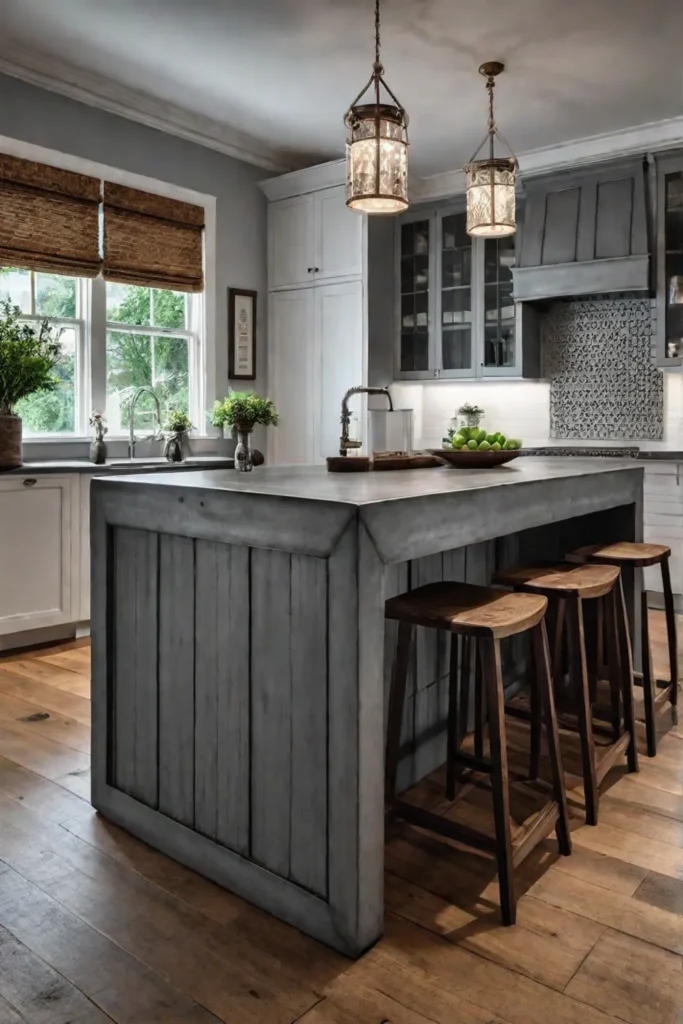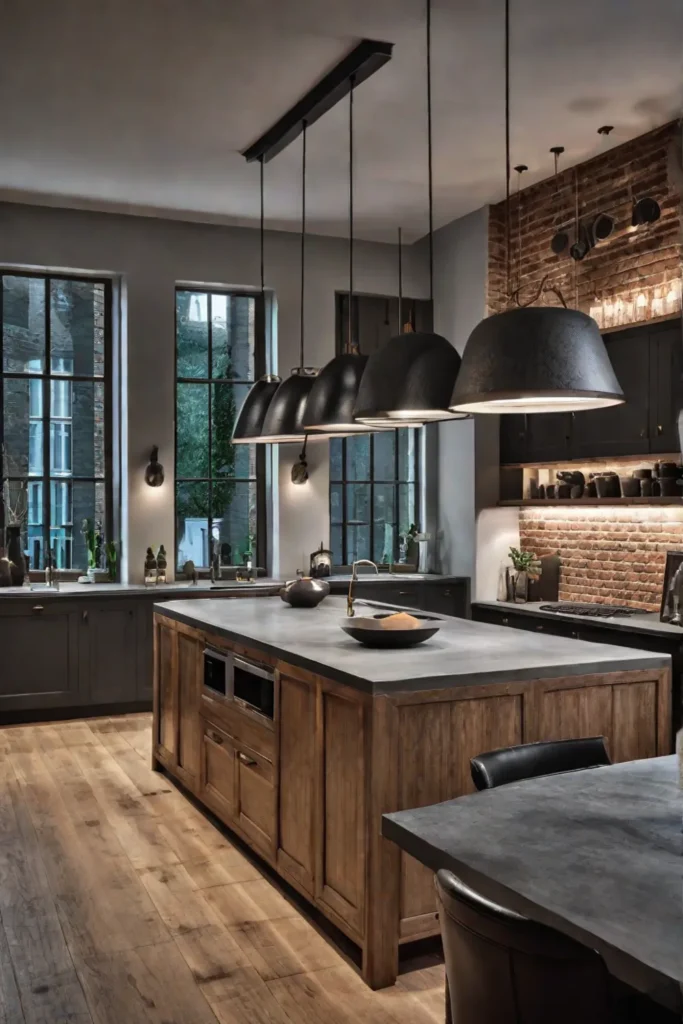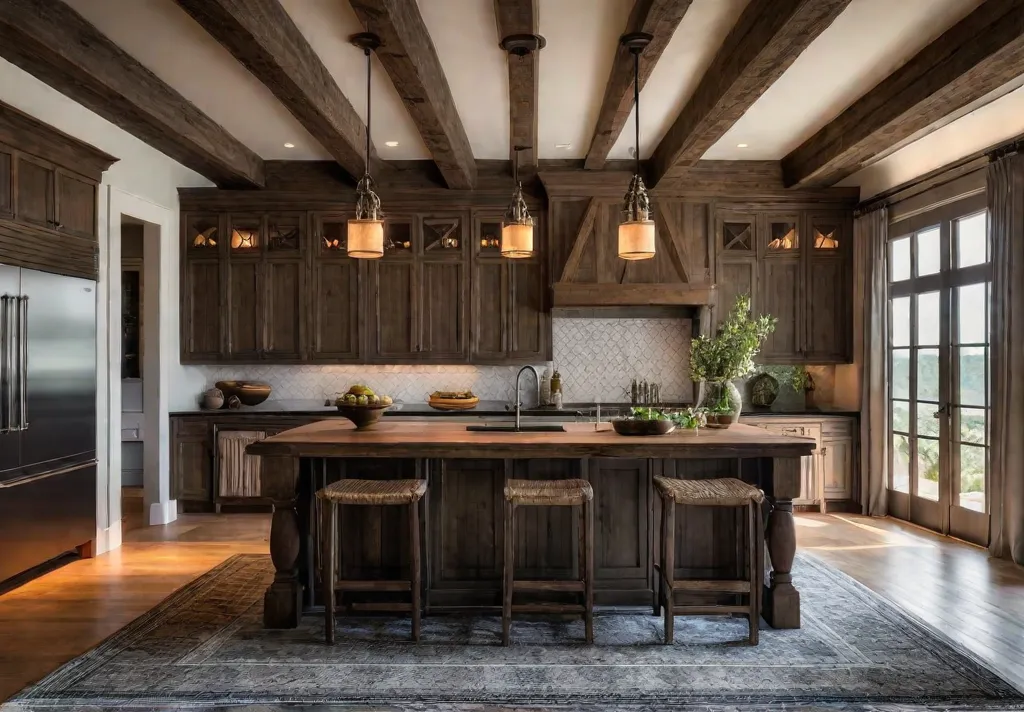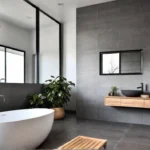Imagine standing in your kitchen, running your fingers across the smooth surface of your island countertop. What story does it tell? In the quest for a truly rustic kitchen, we often overlook the heart of our culinary space – the island. But what if I told you that your countertop could be more than just a prep surface? It could be a statement piece, a conversation starter, and a testament to sustainable living.
As we embark on this journey of discovery, we’ll explore five creative countertop ideas that go beyond the traditional butcher block. From the quiet elegance of soapstone to the industrial chic of concrete, each option offers a unique blend of functionality and aesthetics. We’ll delve into materials that not only complement your rustic kitchen but also align with a mindful, eco-conscious lifestyle. So, let’s reimagine your kitchen island as a canvas for self-expression and sustainable design.
The Enduring Beauty of Soapstone
In our quest for sustainable and timeless kitchen design, we often overlook the quiet elegance of soapstone. This natural material, with its soft matte finish and subtle veining, offers a perfect blend of rustic charm and modern sophistication for your kitchen island countertop.

A Material with History and Character
Soapstone has been a staple in kitchens for centuries, gracing countertops and sinks with its understated beauty. Its enduring popularity is a testament to its versatility and durability. As you run your hand across a soapstone surface, you’ll feel a connection to the earth and to generations of artisans who have worked with this material.
What sets soapstone apart is its ability to develop a rich patina over time. Each scratch, each stain, becomes part of the stone’s story, adding depth and character that can’t be replicated by manufactured materials. It’s a living surface that evolves with your kitchen, becoming more beautiful with each passing year.
Durability Meets Low Maintenance
One of the most appealing aspects of soapstone is its natural resistance to heat and stains. For those of us who love to cook and entertain, this means less worry about hot pots leaving marks or red wine spills becoming permanent fixtures.
Maintenance is refreshingly simple:
- Regular oiling with mineral oil to enhance the stone’s natural darkening process
- Gentle cleaning with soap and water for daily care
- No need for harsh chemicals or sealants
The soft nature of soapstone is an advantage in the kitchen. It’s less likely to chip your favorite dishes, making it a forgiving surface for busy cooks and families.

Aesthetic Versatility
Soapstone typically comes in shades of gray, often with subtle green or blue undertones. This neutral palette makes it an ideal backdrop for both traditional and contemporary kitchen designs. Whether you’re aiming for a farmhouse feel or a more minimalist aesthetic, soapstone can adapt to your vision.
Finish options for soapstone countertops include:
- Natural matte finish
- Honed surface for a smoother look
- Waxed finish for added luster
Each finish option allows the stone’s natural beauty to shine through while offering a unique tactile experience.
Cost Considerations
When it comes to cost, soapstone falls into the mid to high range of countertop materials. While it may be more expensive than some engineered options, its longevity and timeless appeal make it a worthwhile investment for many homeowners. Consider soapstone an heirloom material that will serve your family for generations to come.
To get the most value from your investment:
- Work with reputable suppliers who source high-quality stone
- Hire experienced installers familiar with soapstone’s unique properties
- Factor in the long-term durability and low maintenance costs when comparing prices

Embracing Imperfection
As we move towards more mindful, sustainable living, it’s important to embrace materials that age gracefully. Soapstone teaches us to appreciate the beauty in imperfection. Each mark and subtle change in color tells a story of meals shared and memories made in your kitchen.
By choosing soapstone for your rustic kitchen island, you’re not just selecting a countertop material – you’re inviting a piece of living history into your home. It’s a choice that honors both the environment and the artistry of natural materials.
As we explore the diverse world of rustic countertop options, let’s shift our gaze from the organic elegance of soapstone to another material that marries industrial chic with earthy appeal. In our next section, we’ll dive into the world of concrete countertops, where raw urban aesthetics meet endless creative possibilities.
The Industrial Chic of Concrete Countertops
Concrete countertops are emerging as a bold, versatile choice that marries industrial edge with organic warmth. As we explore this innovative material, we’ll discover how it can transform your kitchen island into a statement piece that’s both functional and visually striking.

The Allure of Concrete
Concrete’s raw, tactile nature speaks to our innate connection with the earth. It’s a material that feels simultaneously ancient and modern, grounding our kitchens in a sense of timelessness while offering cutting-edge design possibilities. The beauty of concrete lies in its ability to be molded into any shape, colored to match any palette, and textured to suit any aesthetic.
Customization: Your Imagination is the Limit
One of concrete’s most compelling attributes is its chameleon-like adaptability. Whether you’re drawn to smooth, polished surfaces or prefer a more rugged, weathered look, concrete can accommodate your vision. Here are some ways to personalize your concrete countertop:
- Integral color: Mix pigments directly into the concrete for a uniform hue throughout.
- Staining: Apply acid or water-based stains for a variegated, natural look.
- Embedding: Incorporate recycled glass, stones, or even personal mementos for a truly unique surface.
- Edge profiles: From sleek squared edges to organic live edges, the possibilities are endless.
- Textures: Experiment with smooth, board-formed, or even exposed aggregate finishes.
Poured-in-Place vs. Precast: Choosing Your Path
When it comes to installation, you have two primary options: poured-in-place or precast concrete countertops. Each has its advantages:

Poured-in-Place:
- Perfect for custom shapes and seamless integration
- Allows for on-site adjustments
- Can be challenging in terms of curing time and workspace disruption
Precast:
- A controlled environment ensures consistent quality
- Faster installation process
- Easier to achieve complex designs and inlays
Ultimately, the choice depends on your specific project requirements and timeline. Consulting with a concrete specialist can help you make the best decision for your kitchen.
Sealing and Care: Preserving Your Concrete Canvas
To maintain the beauty and integrity of your concrete countertop, proper sealing is essential. A high-quality sealer will protect against stains, etching, and moisture absorption. Look for food-safe, penetrating sealers that enhance the natural beauty of the concrete without altering its appearance.
Care tips:
- Reseal annually or as recommended by your fabricator
- Clean with pH-neutral soap and water
- Use cutting boards and trivets to prevent scratches and heat damage
- Wipe up spills promptly, especially acidic substances like wine or citrus juice
Embracing the Patina
One of concrete’s most charming characteristics is its ability to develop a unique patina over time. Like a well-worn leather jacket, your concrete countertop will tell a story of use and care, becoming more beautiful with age. Embrace this evolution as part of your kitchen’s journey.

Preventing Cracks: The Art of Reinforcement
While concrete is incredibly durable, proper reinforcement is key to preventing cracks. Professional fabricators use a combination of techniques:
- Steel rebar or wire mesh for structural strength
- Fiber reinforcement to prevent microcracking
- Proper mix design to control shrinkage
- Adequate curing time to ensure full strength
By working with experienced professionals and following proper care guidelines, you can ensure your concrete countertop remains a stunning focal point for years to come.
As we transition from the raw, earthy appeal of concrete, let’s explore another timeless option that brings a different kind of elegance to your rustic kitchen island. In our next section, “Timeless Elegance with Tile Countertops,” we’ll discover how this classic material can be reimagined for contemporary rustic spaces.
Timeless Elegance with Tile Countertops
Tile countertops offer a unique blend of durability and aesthetic versatility. As we explore this option for your kitchen island, we’ll discover how tiles can transform a functional surface into a stunning focal point that honors both tradition and sustainability.

Embracing Nature’s Palette
When selecting tiles for your countertop, consider materials that resonate with the earth’s natural beauty. Ceramic and porcelain tiles, with their endless array of colors and textures, can mimic the look of stone or wood while offering superior durability. For those seeking an authentic touch, natural stone tiles like slate, granite, or travertine bring the raw essence of the outdoors into your kitchen space.
Tip: Opt for larger format tiles to minimize grout lines and create a more seamless look, or experiment with smaller mosaic tiles for intricate patterns that tell a story.
The Art of Pattern Play
One of the most compelling aspects of tile countertops is the opportunity for creative expression through patterns. Here are some ideas to inspire your design:
- Herringbone: A classic pattern that adds movement and sophistication
- Basketweave: Perfect for creating a sense of depth and texture
- Moroccan fish scale: For a touch of exotic elegance
- Hexagon: A modern twist that still feels organic and natural
Remember, the pattern you choose should complement the overall aesthetic of your kitchen while reflecting your style.
Grout: The Unsung Hero
While often overlooked, grout plays a crucial role in both the appearance and functionality of your tile countertop. When selecting grout, consider:
- Color: A contrasting grout color can highlight your tile pattern, while a matching hue creates a more uniform look.
- Type: Epoxy grouts offer superior stain and water resistance, ideal for kitchen environments.
- Width: Wider grout lines create a more rustic feel, while thinner lines appear more refined.

To maintain your grout’s integrity and appearance:
- Seal it annually with a high-quality grout sealer
- Clean regularly with a pH-neutral cleaner
- Avoid harsh chemicals that can erode the grout over time
Sustainability Considerations
As we strive for more eco-conscious living spaces, it’s worth noting that many tile options align with sustainable design principles. Look for tiles made from recycled materials or those produced using environmentally friendly processes. Local artisan-made tiles not only support your community but also reduce the carbon footprint associated with transportation.
Practical Maintenance
One of the advantages of tile countertops is their relatively easy maintenance. To keep your surface looking its best:
- Wipe spills immediately to prevent staining
- Use cutting boards to protect the surface from scratches
- Avoid placing hot pots directly on the tiles, even though they are heat-resistant
By choosing tiles that resonate with your home’s natural surroundings and maintaining them with care, you create a countertop that’s not just a surface, but a reflection of your commitment to mindful living.
As we transition from the timeless elegance of tile, let’s explore another option that speaks to the heart of sustainable design. In our next section, we’ll delve into the world of reclaimed wood and discover how this material can become a sustainable statement piece in your rustic kitchen island.
Reclaimed Wood: A Sustainable Statement Piece
In our quest for conscious design, reclaimed wood emerges as a powerful ally. This versatile material not only brings warmth and character to rustic kitchens but also tells a story of sustainability and rebirth.

The Allure of History
Reclaimed wood carries within its grains the whispers of its past life. Each plank, whether salvaged from an old barn, a decommissioned factory, or even a retired ship, brings a unique narrative to your kitchen island. The weathered patina, nail holes, and saw marks aren’t imperfections – they’re badges of honor, testifying to the wood’s journey through time.
Sourcing with Intention
To embark on your reclaimed wood adventure:
- Seek out reputable salvage yards or specialized reclaimed wood suppliers
- Visit architectural salvage stores for unique finds
- Connect with local craftsmen who work with reclaimed materials
- Explore online marketplaces dedicated to reclaimed wood
Remember, the goal is to find pieces with authentic character and a verifiable history. Ask about the wood’s origin and previous use – this information adds depth to your design narrative.
Protecting Your Investment
While reclaimed wood exudes rustic charm, it requires thoughtful care to maintain its beauty:
- Apply a food-safe sealer to protect against moisture and stains
- Consider a matte finish to preserve the wood’s natural look
- Use cutting boards and trivets to prevent direct contact with hot items or sharp utensils
- Clean with gentle, pH-neutral products to avoid damaging the wood’s patina

For high-use areas, a durable marine-grade varnish can offer extra protection without compromising the wood’s character.
A Canvas of Possibilities
Reclaimed wood countertops can adapt to various rustic kitchen styles:
- Farmhouse Chic: Pair wide planks with white cabinetry for a classic country look
- Industrial Edge: Combine with metal accents for an urban loft vibe
- Coastal Retreat: Light, weathered wood evokes beachside serenity
- Mountain Lodge: Dark, knotty wood creates a cozy, cabin-like atmosphere
The versatility of reclaimed wood allows it to harmonize with your unique vision of rustic elegance.
By choosing reclaimed wood for your kitchen island countertop, you’re not just designing a space – you’re making a statement. It’s a commitment to sustainability, a celebration of history, and a step towards creating a home that resonates with intention and mindfulness.
As we continue our exploration of innovative countertop materials, let’s shift our gaze to some unexpected alternatives that can infuse your rustic kitchen with even more personality and eco-conscious flair.
Embrace the Unexpected: Alternative Countertop Materials
During our journey to create a truly unique rustic kitchen island, we explored various traditional options. But what if we ventured beyond the expected? Let’s dive into some unconventional materials that can elevate your kitchen island from charming to extraordinary.

Metallics: Stainless Steel, Copper, and Zinc
Metals might not be the first materials that come to mind for a rustic kitchen, but they can add a surprising and delightful contrast to natural wood elements.
Stainless steel offers a sleek, modern edge that can beautifully offset rough-hewn timber. It’s incredibly durable, heat-resistant, and easy to clean – perfect for the serious chef. However, it can show fingerprints and scratches, so be prepared for some regular maintenance.
Copper, with its warm, rosy hue, brings a sense of lived-in luxury to your kitchen. What’s truly magical about copper is its living patina – over time, it develops a rich, variegated surface that tells the story of your culinary adventures. Just be aware that acidic foods can affect its surface, so use cutting boards religiously.
Zinc is perhaps the most intriguing option. It starts as a matte gray but evolves into a complex, mottled patina that’s truly one-of-a-kind. Plus, it has natural antibacterial properties – a boon for any kitchen. Like copper, it’s reactive to acidic foods, so mindful use is key.
Exploring Other Natural Materials: Granite, Slate, Marble
While not as unconventional as metals, these stone options can bring a touch of organic luxury to your rustic kitchen.
Granite, with its speckled patterns and range of colors, offers durability and heat resistance. It’s a timeless choice that can complement a variety of rustic styles, from farmhouse to industrial.

Slate brings a moody, sophisticated vibe with its deep charcoal tones. It’s naturally non-porous, making it resistant to stains and bacteria. However, it can chip if subjected to heavy impacts, so handle it with care.
Marble, with its elegant veining, can add a touch of refinement to your rustic space. It does require more maintenance than other options, as it’s prone to etching and staining. But for many, its timeless beauty is worth the extra effort.
Balancing Aesthetics and Functionality
When considering these alternative materials, it’s crucial to weigh their visual appeal against their practical implications. Here are some key points to ponder:
- Durability: How will the material stand up to daily use? Metals and granite are generally more durable than softer stones like marble.
- Maintenance: Are you willing to put in the effort to maintain the material’s appearance? Copper and zinc develop patinas that some find charming, while others may prefer the consistent look of stainless steel.
- Cost: Alternative materials can be pricier than traditional options. Stainless steel and granite tend to be more budget-friendly, while copper and marble sit at the higher end of the spectrum.
- Integration: Consider how the material will complement your existing decor. A copper countertop can warm up a cool-toned kitchen, while slate can add depth to a lighter palette.
Remember, the goal is to create a space that not only looks beautiful but also functions well for your lifestyle. Don’t be afraid to mix materials – a primarily wooden island with a stainless steel prep area, for instance, can offer the best of both worlds.
As we wrap up our exploration of countertop materials, it’s clear that the possibilities are vast and exciting. Whether you opt for the warmth of copper, the evolving beauty of zinc, or the timeless elegance of stone, your choice will play a crucial role in defining your kitchen’s character. In our final section, we’ll bring together all we’ve discussed and provide some closing thoughts on creating your perfect rustic kitchen island.

Conclusion
As we conclude our exploration of creative countertop ideas for your rustic kitchen island, it’s clear that the possibilities are as vast as they are inspiring. Each material we’ve discussed – from the timeless beauty of soapstone to the unexpected allure of metal – offers a unique opportunity to infuse your space with character and intention. The choice you make isn’t just about aesthetics; it’s a reflection of your values and your vision for a more mindful home.
Remember, the heart of rustic design lies in its connection to nature and authenticity. Whether you opt for the evolving patina of reclaimed wood or the industrial edge of concrete, your countertop should tell a story – your story. As you move forward in your design journey, I encourage you to think beyond the surface. Consider how your choice will impact not just your daily life, but also the environment and the artisans behind the materials. By doing so, you’re not just creating a kitchen island; you’re crafting a centerpiece that honors the past, celebrates the present, and looks toward a more sustainable future. Let your countertop be a testament to conscious living, one that invites connection, creativity, and a deeper appreciation for the beauty of imperfection.






